Blank B.E., Krantz S.G. Calculus: Single Variable
Подождите немного. Документ загружается.


Because x
2
1 x 5 (x 1 1) x, we see that f (x) is the product of one positive term and
one negative term when 21 , x , 0. Thus f (x) , 0 for 21 , x , 0. Also, f (x)is
clearly nonnegative for x $ 0. From these observations, it follows that
jf ðxÞj5 f
2ðx
2
1 xÞ if 21 , x , 0
x
2
1 x if 0 # x
Therefore
Z
2
21
f ðxÞ
dx 5
Z
0
21
2 ðx
2
1 xÞdx 1
Z
2
0
ðx
2
1 xÞdx 5
29
6
:
As a result, we have
Z
2
21
f ðxÞdx
5
9
2
5
9
2
5
27
6
,
29
6
5
Z
2
21
jf ðxÞjdx;
which agrees with inequality (5.3.6).
¥
The Mean Value
Theorem for Integrals
In Chapter 4, we learned a Mean Value Theorem for derivatives. We will now
demonstrate an analogous theorem for integrals.
THEOREM 7
(Mean Value Theorem for Integrals). Let f be continuous on
[a, b]. There is a value c in the open interval (a, b) such that
f ðcÞ5
1
b 2 a
Z
b
a
f ðxÞdx: ð5:3:7Þ
Proof. Let m and M be
the minimum and maximum values of f on [a, b]. These
values exist by the Extreme Value Theorem (Section 2.3 of Chapter 2). The
function g (x) 5 (b 2 a) f (x) is continuous on [a, b]. The minimum and maximum
values of g on [a, b]areα 5 m (b 2 a)andβ 5 M (b 2 a), respectively. According to
line (5.3.5), the number
R
b
a
f ðxÞdx lies between α and β. The Intermediate Value
Theorem assures us that such an intermediate number can be realized as a value of g.
In other words, there is a point c in the interval (a, b)suchthat
gðcÞ5
Z
b
a
f ðxÞdx:
Because g (c) 5 (b 2 a)f (c), equation (5.3.7) follows. ’
The av
erage value f
avg
of f on [a, b] is defined to be
f
avg
5
1
b 2 a
Z
b
a
f ðxÞdx:
The Mean Value Theorem for Integrals tells us that a continuous function assumes
its average value. There is no such theorem for discrete functions. For example, if
you take two exams and score 80 and 90, then your average is 85. However, you did
not score 85 on either exam—the average value 85 is not assumed. In Section 7.3 in
Chapter 7, we motivate the definition of average value. For now, we are content
ac b
f
f
(c)
b a
f
ave
m Figure 2 f
avg
(b 2 a) 5 area
of shaded rectangle 5
R
a
b
f (x) dx
5.3 Rules for Integration 405
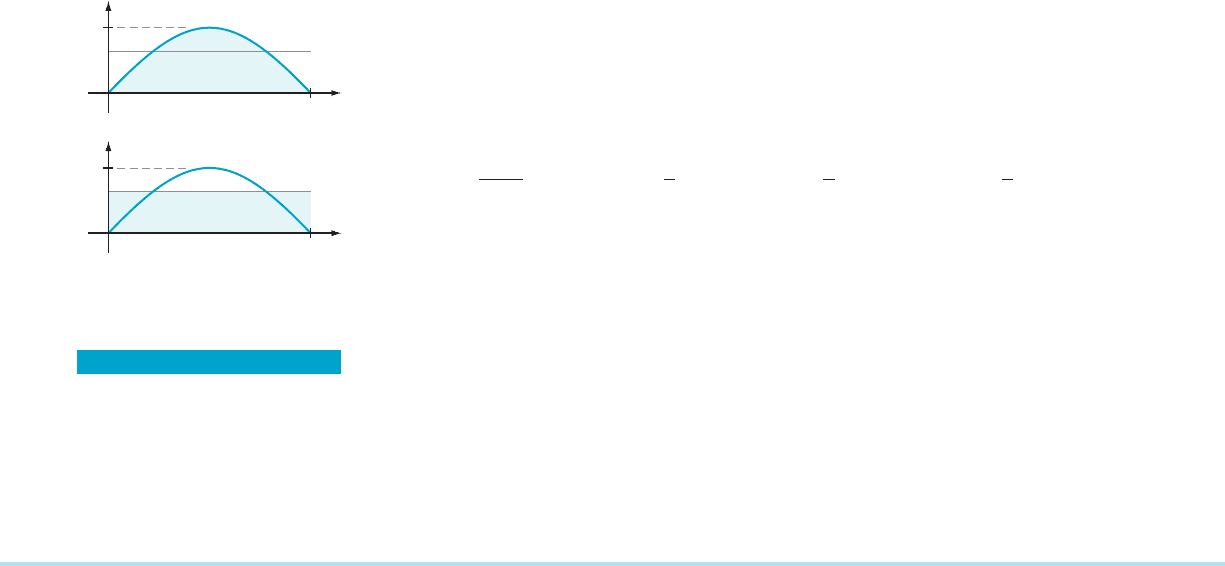
with the geometric interpretation of average value: If f is positive on [a, b], then the
area under the graph of f over [a, b] equals the area of the rectangle with base [a, b]
and height f
avg
:
Z
b
a
f ðxÞdx ¼ f
avg
ðb 2 aÞ:
This is illustrated in Figure 2.
⁄ EX
AMPLE 10 Compute the average value of f (x) 5 sin(x)
for 0 # x # π.
Solution Because 2 cos( x )
is an antiderivative of sin(x), we use Theorem 3 from
Section 5.2 to calculate the average value of f on [0, π] as follow s:
f
avg
5
1
π 2 0
Z
π
0
sinðxÞdx 5
1
π
2cosðxÞ
π
0
5
1
π
2ð21Þ2 ð21Þ
5
2
π
:
See Figure 3. Notice that the average value is not the
average of the values of f at
the endpoints (which is 0 in this case). It is not the average of the maximum and
minimum values of f on the interval (which is 1/2 in this case). Also, it is not the
value of f at the midpoint of the interval (which is 1 in this case).
¥
QUICK QUIZ
1. What is
R
5
5
tan
3
ðxÞdx
2. Calcul ate
R
23
3
x
2
dx:
3. If
R
2
0
f ðxÞdx 5 3and
R
7
0
f ðxÞdx 525, then what is
R
2
7
3 f ðxÞ dx?
4. What is the average value of f (t) 5 t
2
for 1 # t # 4?
Answers
1. 0 2. 218
3. 24 4. 7
f
ave
1
1
f
ave
y sin(x)
p
x
y
x
y
y 2
p
p
m Figure 3 The shaded regions
have equal areas.
EXERCISES
Problems for Practice
1. Suppose that
R
3
1
f ðxÞdx 528 and
R
7
3
f ðxÞdx 5 12. Evalu-
ate
R
7
1
f ðxÞdx.
2. Suppose that
R
12
2
gðxÞdx 526 and
R
6
2
gðxÞdx 5212.
Evaluate
R
12
6
gðxÞdx.
3. Suppose that
R
3
27
f ðxÞdx 527 and
R
3
27
gðxÞdx 524.
Evaluate
R
3
27
ð4f ðxÞ2 9gðxÞÞdx.
4. Suppose that
R
8
4
f ðxÞdx 5 6. Evaluate
R
4
8
f ðxÞdx.
5. Suppose that
R
22
7
f ðxÞdx 5 6 and
R
9
7
f ðxÞdx 524. Evalu-
ate
R
22
9
f ðxÞdx.
6. Suppose that
R
27
23
gðxÞdx 5 5 and
R
25
23
gðxÞdx 5 12. Eval-
uate
R
25
27
gðxÞdx.
7. Suppose that
R
4
9
f ðxÞdx 5 5 and
R
4
9
gðxÞdx 5 15. Evaluate
R
9
4
ð6f ðxÞ2 7gðxÞÞdx.
8. Suppose that
R
5
3
f ðxÞdx 5 2. Evaluate
R
3
5
24f ðxÞ dx.
9. Suppose that
R
23
5
ð23f ðxÞ =4Þ dx 5 7. Evaluate
R
23
5
ð6f ðxÞ1 1Þdx.
10. Suppose that
R
29
2
f ðxÞdx 5 5. Evaluate
R
2
29
ð3f ðxÞ2 5xÞdx.
11. Suppose that
R
4
1
f ðxÞ=3dx 5 2. Evaluate
R
1
4
3f ðxÞdx.
12. Suppose that
R
4
0
2f ðxÞ2 x
2
dx 5 6. Evaluate
R
4
0
f ðxÞdx.
13. Suppose that
R
1
2
f ðxÞdx 5 0 and
R
1
2
gðxÞdx 5 0. Evaluate
R
1
2
ðf ðxÞ2 3gðxÞ1 5Þdx.
14. Suppose that
R
8
6
ð3f ðxÞ2 xÞdx 5 6 and
R
6
8
ð2x 1 4gðxÞÞdx 528. Evaluate
R
6
8
ðf ðxÞ2 5gðxÞÞdx.
c In Exercises 15220, compute the average value f
avg
of f
over [a, b] and find a point c in (a, b) for which f (c) 5 f
avg
.
Illustrate the geometric significance of c with a sketch
accompanied by a description. b
15. f (x) 5 1 1 xa5 1, b 5 5
406 Chapter 5 The Integral

16. f (x) 5 x
3
a 5 0, b 5 2
17. f ðxÞ5
ffiffiffi
x
p
a 5 1; b 5 4
18. f (x) 5 1/x
2
a 5 1/2, b 5 2
19. f (x) 5 12x
2
1 5 a 5 0, b 5 3
20. f (x) 5 2x 1 2/xa5 1, b 5 e
c In Exercises 21228, compute the average value of f over
[a, b] b
21. f (x) 5 8 2 x
3
a 524, b 5 2
22. f (x) 5 x
2
1 1/x
2
a 5 1, b 5 3
23. f ðxÞ5
ffiffiffi
x
p
2 1=
ffiffiffi
x
p
a 5 1; b 5 4
24. f (x) 5 e
x
a 5 0, b 5 2
25. f (x) 5 cos(x) a 5 0, b 5 π/2
26. f (x) 5 sin(x) a 52π/2, b 5 π/3
27. f (x) 5 sec
2
(x) a 5 0, b 5 π/4
28. f (x) 5 sec(x) tan(x) a 5 π/4, b 5 π/3
c In each of Exercises 29232, an integral is given. Do not
attempt
to calculate its value V. Instead, use the inequalities
of line (5.3.5) (as in Example 8) to find numbers A and B such
that A # V # B. b
29.
R
3
0
ffiffiffiffiffiffiffiffiffiffiffiffiffi
9 1 x
3
p
dx
30.
R
6
1
x
ffiffiffiffiffiffiffiffiffiffiffi
3 1 x
p
dx
31.
R
4
0
ð25 2 x
2
Þ
21=2
dx
32.
R
π=3
π=4
sin
2
ðxÞdx
Further Theory and Practice
c In Exercises 33236, use the information to determine
R
b
a
f ðxÞdx and
R
b
a
gðxÞdx. b
33.
R
b
a
ðf ðxÞ2 3gðxÞÞdx 5 3;
R
b
a
ð26gðxÞ1 9f ðxÞÞdx 5 6
34.
R
b
a
ðf ðxÞ1 4gðxÞÞdx 5 5;
R
b
a
3gðxÞdx 522
35.
R
b
a
ðf ðxÞ1 2gðxÞÞdx 527;
R
b
a
ðgðxÞ2 f ðxÞÞdx 5 4
36.
R
b
a
ðf ðxÞ2 7gðxÞÞdx 529;
R
b
a
ðgðxÞ1 f ðxÞÞdx 5 0
c In Exercises 37244, use Theorem 3 from Section 5.2 with
one
or more parts of Theorem 1 from this section to calculate
the given definite integral. b
37.
Z
3
1
3x 2 5
x
dx
38.
R
3
1
xð4x
2
2 2Þ dx
39.
R
0
21
ð6x
2
1 e
x
Þdx
40.
R
2
1
ðx 2 2Þðx 1 3Þ dx
41.
R
1
0
ffiffiffi
x
p
ð1 2 xÞdx
42.
Z
1=4
0
x 2 1
ffiffiffi
x
p
2 1
dx
43.
R
1
0
3e
x
ð2 2 e
2x
Þdx
44.
Z
π=2
π=4
xsinðxÞ1 1
3x
dx
45. Suppose that p and q are constants with p . 0 and q . 0.
Is it ever true that
Z
1
0
x
p
x
q
dx 5
Z
1
0
x
p
dx
Z
1
0
x
q
dx?
46. When is it true that
Z
b
a
f ðxÞ1dx 5
Z
b
a
f ðxÞdx
Z
b
a
1 dx?
47. Find an example of a function f, a function g, and values
of a and b such that
Z
b
a
f ðxÞ
gðxÞ
dx 6¼
R
b
a
f ðxÞdx
R
b
a
gðxÞdx
:
c In each of Exercises 48251, a definite integral is given. Do
not
attempt to calculate its value V. Instead, find the extreme
values of the integrand on the interval of integration, and use
these extreme values together with the inequalities of line
(5.3.5) to obtain numbers A and B such that A # V # B. b
48.
Z
2
21
x
2
1 5
x 1 2
dx
49.
Z
4
1
1
x
2
2 4x 1 5
dx
50.
Z
3
0
ðx 1 1Þ
2
x
2
1 1
dx
51.
R
3
1
xe
2x=2
dx
52. Use trigonometric identities to evaluate
R
π=2
0
cos
2
ðx=2Þdx
and
R
π
0
sin
2
ðxÞdx.
c In each of Exercises 53258, F (x)
is a function of a variable
x that appears in a limit (or in the limits) of integration of a
given definite integral. Express F (x) explicitly by calculating
the integral. b
53. FðxÞ5
R
x
1
ð3t
2
1 1Þdt
54. FðxÞ5
R
x
π=6
2 cosðtÞdt
55. FðxÞ5
R
1
x
ð2t 1 1=t
2
Þdt
56. FðxÞ5
R
2x
x
ð2t 1 3t
2
Þdt
57. FðxÞ5
Z
x
2
1
1
ffiffi
t
p
dt
58. FðxÞ5
R
x
2
x
ð2 1
ffiffi
t
p
Þdt
c In each of Exercises 59262, verify that inequality (5.3.6)
holds
for the given integrand f and interval I of integration. b
59. f (x) 5 πx 2 3 I 5 [0,
1]
60. f (x) 5 sin(x) 2 cos(x) I 5 [0, π/3]
61. f (x) 5 1 2 9x
2
I 5 [22, 1]
62. f (x) 5 e
x
2 7 I 5 [0, 2]
63. Let P
2
(x) 5 (3x
2
2 1)/2. This polynomial is called the
degree 2 Legendre polynomial. Show that if Q (x) 5
Bx 1 C for constants B and C, then
5.3 Rules for Integration 407
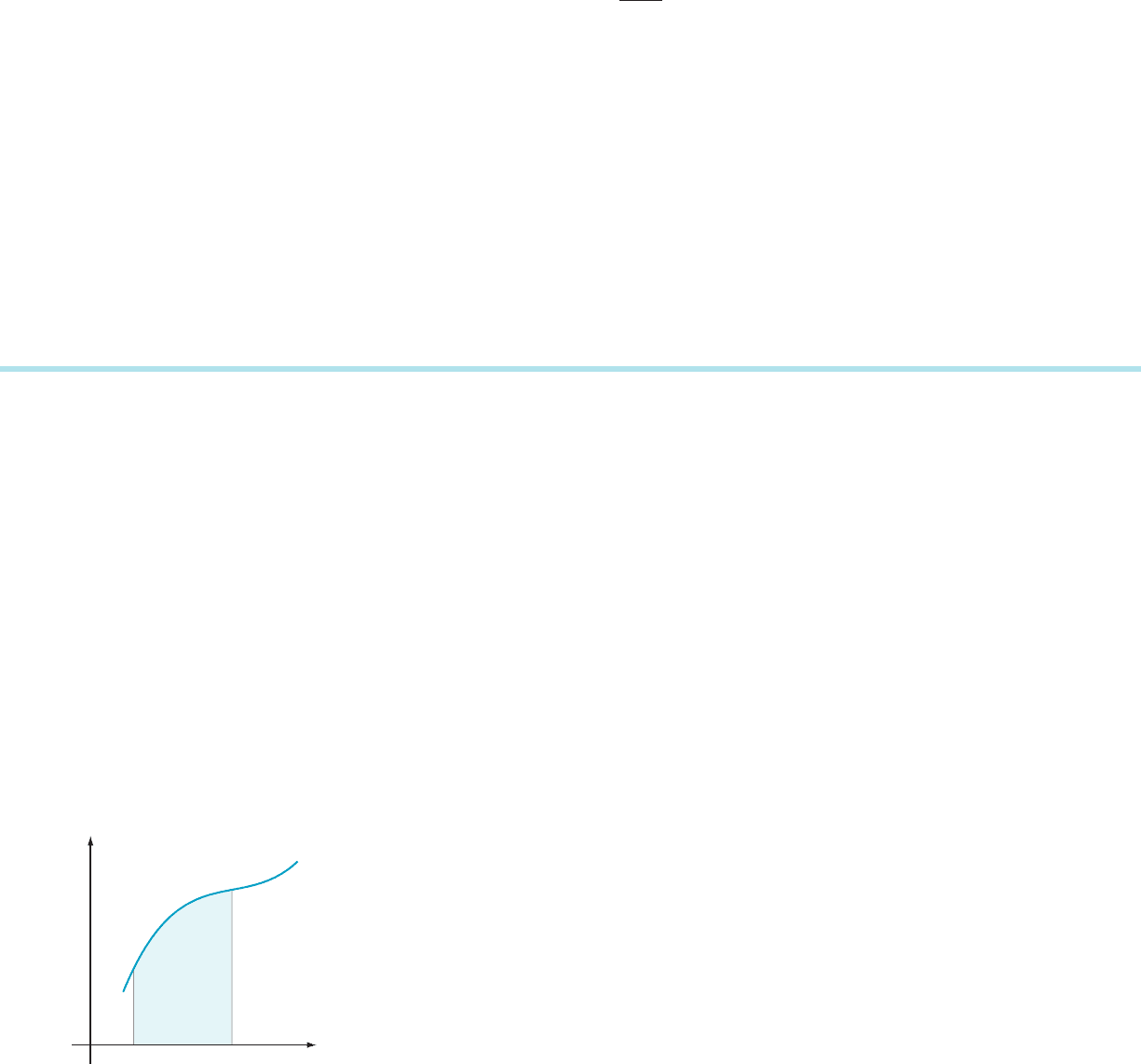
Z
1
21
P
2
ðxÞQðxÞdx 5 0:
64. Let P
3
(x) 5 (5x
3
2 3x)/2. This polynomial is called the
degree 3 Legendre polynomial. Show that if Q (x) 5
Ax
2
1 Bx 1 C for constants A, B, and C, then
Z
1
21
P
3
ðxÞQðxÞdx 5 0:
Calculator/Computer Exercises
c In each of Exercises 65268, a definite integral is given. Do
not attempt to calculate its value V. Instead, find the extreme
values of the integrand on the interval of integration, and use
these extreme values together with the inequalities of line
(5.3.5) to obtain numbers A and B such that A # V # B. b
65.
Z
2
0
1 1 x
1 1 x
4
dx
66.
R
3=2
0
ð
ffiffiffi
x
p
2 sinð xÞÞ dx
67.
R
π=2
0
ð3 sinðx
2
Þ1 cosðxÞÞ dx
68.
R
1
1=2
e
2x
lnð1 1 xÞ dx
c In Exercises 69272, compute the average value f
avg
of f
over [a, b], and find a value of c in (a, b) at which f attains this
average value. Illustrate the geometric meaning of the Mean
Value Theorem for Integrals with a graph. b
69. f (x) 5 x 1 sin
(x) a 5 0, b 5 π/2
70. f (x) 5 x
2
1 cos (x) a 5 0, b 5 π
71. f (x) 5 x
2
1 4/xa5 2 b 5 6
72. f (x) 5 (x
3
2 4x 1 6)/3 a 5 0, b 5 2
5.4 The Fundamental Theorem of Calculus
Theorem 3 from Section 5.2 tells us that, if f is continuous on [a, b]andif f has an
antiderivative F on [ a , b], then
Z
b
a
f ðtÞdt 5 FðbÞ2 FðaÞ: ð5:4:1Þ
This equation is the first part of the Fundamental Theorem of Calculus. In this
section, we learn that every continuous function f has an antiderivative. This fact
constitutes the second part of the Fundamental Theorem of Calculus.
In the analytic proof of the second part of the Fundamental Theorem of
Calculus, we assume only that f is a continuous function. However, we will motivate
this theorem geometrically by considering areas. Therefore for the purposes of this
discussion, we suppose that f is positive in addition to being continuous. To this
function f we associate an area function F that is defined by
FðxÞ5
Z
x
a
f ðtÞdt: ð5:4:2Þ
Figure 1 shows the graph of y 5 f (t) in the ty-plane. As Figure 1 indicates, the value
of F (x) is the area of the region that lies below the graph of f, above the t-axis, and
between the vertical lines t 5 a and t 5 x. Notice that F is a function of the upper
limit x of integration, not of the symbol t that appears within the integral. Also, we
do not assume that an explicit formula for F (x) can be found. It is known, for
example, that the area function FðxÞ5
R
x
a
2 1 cos ðt
2
Þ
dt cannot be expressed in
terms of finitely many elementary functions. It is precisely such area functions that
we wish to understand.
The main result of this section is that F is an antiderivative of f. In other words,
F is a differentiable function and F
0
5 f. To prove these assertions, we refer to the
definition of the derivative and look at the difference quotient:
ax
t
y
y f(t)
Area F(x)
m Figure 1
408 Chapter
5 The Integral
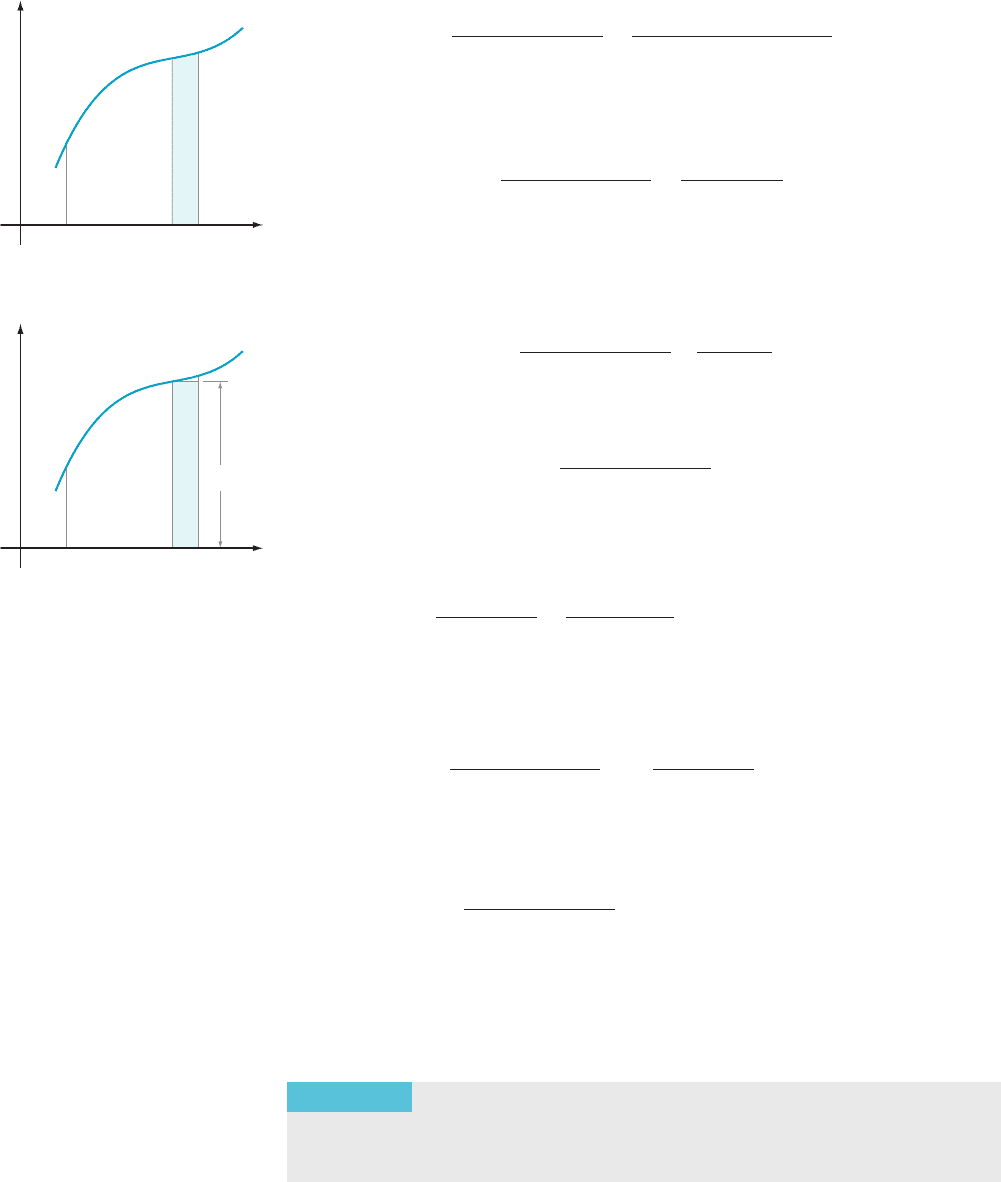
Fðx 1 ΔxÞ2 FðxÞ
Δx
5
R
x1Δx
a
f ðtÞdt 2
R
x
a
f ðtÞdt
Δx
:
We now use Theorem 3 from Section 5.3 to rewrite the numerator of the right
side of this equation. We obtain
Fðx 1 Δ x Þ2 FðxÞ
Δx
5
R
x1Δx
x
f ðtÞdt
Δx
: ð5:4:3Þ
The numerator
R
x1Δx
x
f ðtÞdt represents the area of the shaded region in Figure 2.
When Δx is small, the integral
R
x1Δx
x
f ðtÞdt is nearly equal to the area of a rectangle of
base Δx and height f (x)(seeFigure3).Therefore
Fðx 1 Δ x Þ2 FðxÞ
Δx
f ðxÞΔx
Δx
as Δx - 0. Thus we have intuitively deduced that
lim
Δx-0
Fðx 1 Δx Þ2 FðxÞ
Δx
5 f ðxÞ:
We can make this argument rigorous by appealing to the Mean Value Theorem for
Integrals, which tells us that there exists a c between x and x 1 Δx such that
R
x1Δx
x
f ðtÞdt
Δx
5
1
ðx 1 Δ x Þ2 x
Z
x1Δx
x
f ðtÞdt 5 f ðcÞ: ð5:4:4Þ
By combining equations (5.4.3) and (5.4.4), we find that for any Δx,thereisac
between x and x 1 Δx such that
Fðx 1 Δ x Þ2 FðxÞ
Δx
5
ð5:4:3Þ
R
x1Δx
x
f ðtÞdt
Δx
5
ð5:4:4Þ
f ðcÞ: ð5:4:5Þ
Because c lies between x and x 1 Δx, it follows that c - x as Δx - 0. From these
observations, we obtain
lim
Δx-0
Fðx 1 Δ x Þ2 FðxÞ
Δx
5 lim
Δx-0
f ðcÞ5 lim
c-x
f ðcÞ5 f ðxÞ;
where the last equality results from the continuity of f. This equation means that the
derivative of F at x exists and equals f (x). In short, F is an antiderivative for f.The
theorem that follows combines the two parts of the Fundamental Theorem of
Calculus.
THEOREM 1
(Fundamental Theorem of Calculus). Let f be a continuous
function on the interval [a, b].
a. If F is any antiderivative of f on [a, b], then
x xax
y f(t)
F(x)
t
y
m Figure 2 Area 5
R
x
x1Δ
f (t) dt
f(x)
x xax
y f(t)
F(x)
t
y
m Figure 3
R
x
x1Δ
f (t) dt is ap-
proximately the area f (x) Δx of
the shaded rectangle.
5.4 The Fundamental Theorem of Calculus 409
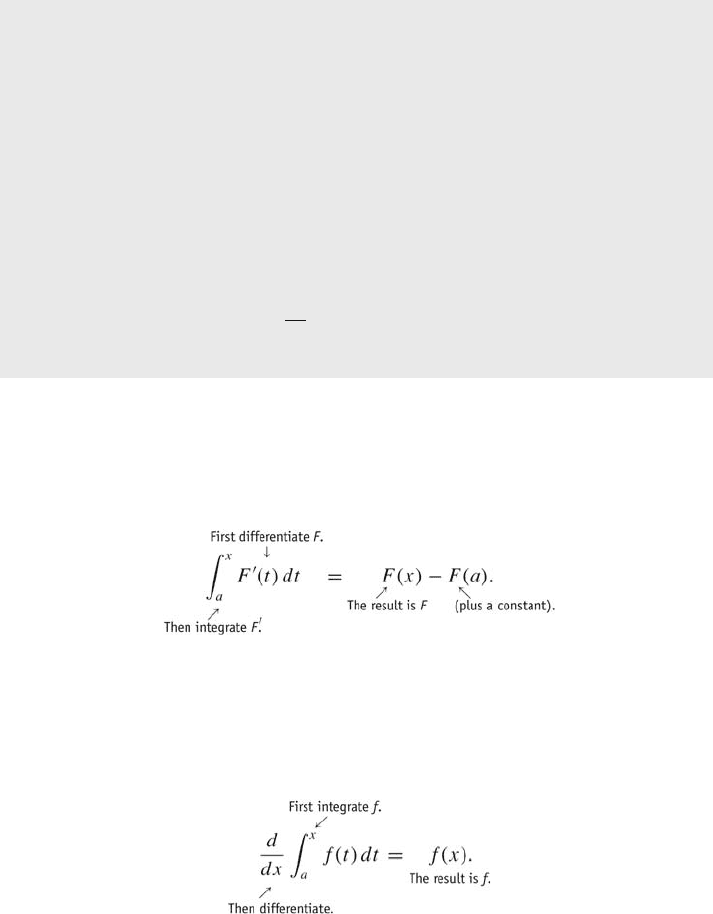
Z
b
a
f ðtÞdt 5 FðbÞ2 FðaÞ:
b. The function F defined by
FðxÞ5
Z
x
a
f ðtÞdt ða # x # bÞ
is an antiderivative of f. This function F is continuous on [a, b] and
F
0
ðxÞ5 f ðxÞða , x , bÞ:
In Leibniz notation,
d
dx
Z
x
a
f ðtÞdt 5 f ðxÞ: ð5:4:6Þ
Together, the two parts of the Fundamental Theorem inform us that differ-
entiation and integration are inverse operat ions. Let us apply the first part of the
Fundamental Theorem to a continuous derivative F
0
. Because F is an anti-
derivative of F
0
, we obtain
Thus if we differentiate F and integrate the derivative, then we recover the function
F with which we started (plus the constant 2F (a)). The second part of the Fun-
damental Theorem, equation (5.4.6) , tells us that if we integrate the function f and
then differentiate with respect to the upper limit of integration, then we recover the
function f with which we started:
We therefore think of integration and differentiation as processes that are inverse
to one another.
Examples Illustrating
the First Part of the
Fundamental Theorem
We have been using the first part of the Fundamental Theorem of Calculus since
Section 5.2. The integrands in the examples we now consider require greater care
than those found in previous sections.
⁄ EX
AMPLE 1 Compute
R
1
0
e
2t
dt:
Solution To
use the first part of the Fundamental Theorem, we need to find an
antiderivative for the function f (t) 5 e
2t
. Notice that
410 Chapter 5 The Integral

d
dt
e
2t
5 2e
2t
; or
d
dt
1
2
e
2t
5 e
2t
:
Therefore FðtÞ5
1
2
e
2t
is a suitable antiderivative, and
Z
1
0
e
2t
dt 5 FðtÞ
t5 1
t5 0
5
1
2
e
2
2
1
2
e
0
5
1
2
ðe
2
2 1Þ: ¥
INSIGHT
Remember that a definite integral represents a definite number or
expression. Including an arbitrary constant of integration in the final answer (as we would
for an indefinite integral) is wrong. In Example 1, we used the Fundamental Theorem of
Calculus to compute the definite integral
R
1
0
f ðtÞdt . Accordingly, we first computed the
indefinite integral (or antiderivative)
R
f ðtÞdt . At this stage, had we added a constant C to
the indefinite integral F (t) 5 e
2t
/2, it would not have mattered:
Z
1
0
e
2t
dt 5
1
2
e
2t
1 C
t5 1
t5 0
5
1
2
e
2
1 C
2
1
2
e
0
1 C
5
1
2
e
2
1 C
2
1
2
2 C
5
1
2
ðe
2
2 1Þ:
The constant C cancels out and does not appear in the final answer. The definite integral
R
1
0
e
2t
dt represents a unique number. The only correct answer is (e
2
2 1)/2. In particular,
the answer “(e
2
2 1)/2 1 C where C is an arbitrary constant” is incorrect.
⁄ EXAMPLE 2 Calculate
R
π
0
sin
2
ðtÞdt:
Solution Becau
se it is not immediately clear what an antiderivative for sin
2
(t)
might be, we first rewrite the integrand using the Half-Angle Formula (equation
(1.14) from Section 1.6 in Chapter 1),
sin
2
θ
2
5
1 2 cosðθÞ
2
:
Setting θ 5 2t, we obtain sin
2
(t) 5 (1 2 cos(2t))/2. We substitute this identity into
our original integral and find the required antiderivative:
Z
π
0
sin
2
ðtÞ dt 5
Z
π
0
1
2
ð1 2 cosð2tÞÞdt 5
1
2
t 2
1
2
sinð2tÞ
t5π
t50
5
π
2
: ¥
INSIGHT
The Solution to Example 2 begins with the remark that finding an anti-
derivative of sin
2
(t) is not obvious. A common error is to think that because t
3
/3 is
an antiderivative of t
2
, it must follow that sin
3
(t)/3 is an antiderivative of sin
2
(t). This
reasoning is incorrect. We must use the Chain Rule when we differentiate sin
3
(t)/3. We
obtain
d
dt
1
3
sin
3
ðtÞ
5
1
3
3 sin
2
ðtÞ
d
dt
sinðtÞ5 sin
2
ðtÞcosðtÞ;
which shows that sin
3
(t)/3 is an antiderivative of sin
2
(t) cos(t), not of the given integrand
sin
2
( t).
5.4 The Fundamental Theorem of Calculus 411

Examples of the
Second Part of the
Fundamental Theorem
In the second part of the Fundamental Theorem, we define a function in terms of
an integ ral. It is important that you understand this part because it will be the key
to many applications of the integral and also the key to our rigorous approach to
the logarithm funct ion in the next section.
⁄ EX
AMPLE 3 The hydrostatic pressure exerted against the side of a certain
swimming pool at depth x is
PðxÞ5
Z
x
0
t ðsinð2tÞ1 1Þdt:
What is the rate of change of P with respect to depth when the depth is 4?
Solution We
have not yet learned how to calculate an antiderivative of f (t) 5
t (sin(2t) 1 1). However, the second part of the Fundamental Theorem tells us that
we do not need to evaluate the integral that defines P(x) in order to compute P
0
(x).
Because P (x) 5
R
x
0
f ðtÞdt; Theorem 1b tells us that
P
0
ðxÞ5 f ðxÞ5 x ðsinð2xÞ1 1Þ:
In particular, P
0
(4) 5 4 (sin(8) 1 1) 7.957. ¥
⁄ EXAMPLE 4 Calculate the derivative of FðxÞ5
R
x
2
π
sinð
ffiffi
t
p
Þdt with respect
to x.
Solution The
Fundamental Theorem tells us how to different iate an integral with
respect to its upper limit of integration. This exampl e involves an upper limit that is
a function of the variable of differentiation. We must use the Chain Rule. If we let
u 5 x
2
, then
d
dx
FðxÞ¼
d
dx
Z
u
π
sinð
ffiffi
t
p
Þdt ¼
d
du
Z
u
π
sin
ffiffi
t
p
dt
du
dx
¼ sinð
ffiffiffi
u
p
Þ2x
¼ sinð
ffiffiffiffiffi
x
2
p
Þ2x ¼ 2x sinðjxjÞ: ¥
Example 4 illustrates an extension of formula (5.4.6). If u is
a function of x,then
d
dx
Z
uðxÞ
a
f ðtÞdt 5 f ðuðxÞÞ
d
dx
uðxÞ: ð5:4:7Þ
⁄ EX
AMPLE 5 Calculate the derivative of FðxÞ5
R
0
x
expð2t
2
Þdt with
respect to x.
Solution The
Fundamental Theorem tells us how to different iate an integral with
respect to its upper limit of integration, but in this example, the variable of
differentiation is the lower limit of integration. There is a simple remedy: We
reverse the order of integration. Thus
d
dx
Z
0
x
expð2 t
2
Þdt 52
d
dx
Z
x
0
expð2t
2
Þdt 52expð2x
2
Þ: ¥
Example 5 illustrates another extension of formula (5.4.6). We can combine the
ideas
of Examples 4 and 5 to state the extension as follows:
d
dx
Z
b
uðxÞ
f ðtÞdt 52f ðuðxÞÞ
d
dx
uðxÞ: ð5:4:8Þ
412 Chapter 5 The Integral
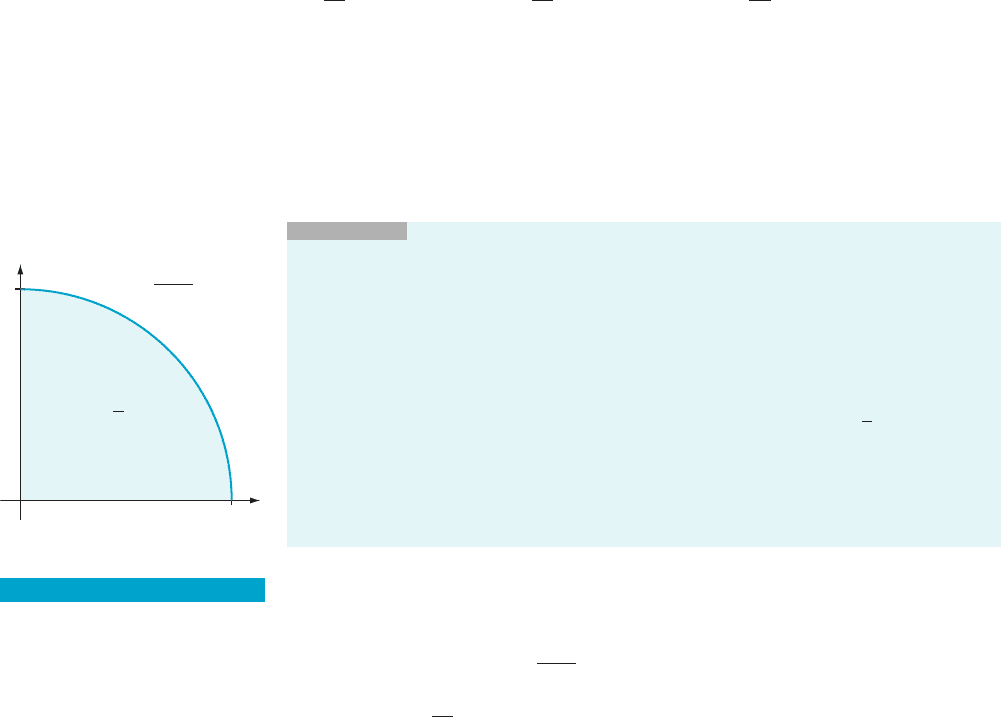
⁄ EXAMPLE 6 Let F be defined by FðxÞ5
R
sinðxÞ
cosðxÞ
ffiffiffiffiffiffiffiffiffiffiffiffi
1 2 t
2
p
dt for 0, , x , π/2.
Differentiate F(x) with respect to x.
Solution This
example involves both upper and lower limits of integration that
depend on x. None of the formulas (5.4.6), (5.4.7), and (5.4.8) is immediately
applicable. However, if we choose any fixed number a and, using (5.3.1), write
FðxÞ 5
Z
sinðxÞ
cosðxÞ
ffiffiffiffiffiffiffiffiffiffiffiffi
1 2 t
2
p
dt 5
Z
a
cosðxÞ
ffiffiffiffiffiffiffiffiffiffiffiffi
1 2 t
2
p
dt 1
Z
sinðxÞ
a
ffiffiffiffiffiffiffiffiffiffiffiffi
1 2 t
2
p
dt
5
Z
sinðxÞ
a
ffiffiffiffiffiffiffiffiffiffiffiffi
1 2 t
2
p
dt 2
Z
cosðxÞ
a
ffiffiffiffiffiffiffiffiffiffiffiffi
1 2 t
2
p
dt;
then we can differentiate each of the two summands using formula (5.4.7):
d
dx
FðxÞ 5
ffiffiffiffiffiffiffiffiffiffiffiffiffiffiffiffiffiffiffiffiffiffi
1 2 sin
2
ðxÞ
q
d
dx
sinðxÞ2
ffiffiffiffiffiffiffiffiffiffiffiffiffiffiffiffiffiffiffiffiffiffiffi
1 2 cos
2
ðxÞ
q
d
dx
cosðxÞ
5
ffiffiffiffiffiffiffiffiffiffiffiffiffiffiffi
cos
2
ðxÞ
p
cosðxÞ2
ffiffiffiffiffiffiffiffiffiffiffiffiffiffi
sin
2
ðxÞ
q
ð2sinðxÞÞ
5 jcosðxÞjcosðxÞ1 jsinðxÞjsinð x Þ
5 cos
2
ðxÞ1 sin
2
ðxÞ because 0 , x , π=2
5 1: ¥
INSIGHT
In Chapter 6, we learn how to directly calculate the integral that defines the
function F from Example 6. But, as with Examples 3, 4, and 5, it is not necessary to
compute F to obtain F
0
. It is therefore interesting to observe that our calculation F
0
(x) 1
actually gives us an indirect way to calculate F(x). Because G (x) 5 x is also an anti-
derivative of the constant function 1, Theorem 5 from Section 4.1 of Chapter 4 tells us that
F (x) 5 G (x) 1 C 5 x 1 C for some constant C. Substituting x 5 0 into this last equation,
we obtain
C 5 Fð0Þ5
Z
sinð0Þ
cosð0Þ
ffiffiffiffiffiffiffiffiffiffiffiffi
1 2 t
2
p
dt 52
Z
1
0
ffiffiffiffiffiffiffiffiffiffiffiffi
1 2 t
2
p
dt
|fflfflfflfflfflfflfflfflfflfflfflffl{zfflfflfflfflfflfflfflfflfflfflfflffl}
Area of 1=4-unit circle
ðsee Figure 4Þ
52
π
4
:
Therefore F (x) 5 x 2 π /4.
QUICK QUIZ
1. Suppose that FðxÞ5
R
x
π
sinðt
2
Þdt. What is F
0
(2)?
2. Suppose that FðxÞ5
R
0
x
ð1 1 t
2
Þ
21
dt. What is F
0
(2)?
3. Suppose that FðxÞ5
Z
2x
x
2 1 t
1 1 t
dt: What is F
0
(1)?
4. Evaluate
Z
1
0
d
dx
ðxe
x
Þdx:
Answers
1. sin(4) 2. 21/5
3. 7/6 4. e
y
t
1
1
Arc of
unit circle
Area p
1
4
1 t
2
y
m Figure 4
5.4 The Fundamental Theorem of Calculus 413

EXERCISES
Problems for Practice
c Use the first part of the Fundamental Theorem of Calculus
together with the ideas of Examples 1 and 2 to evaluate the
definite integrals in Exercises 1210. b
1.
R
2
0
e
3x
dx
2.
R
0
21
e
2x
dx
3.
R
π=4
π=6
12cosð2xÞdx
4.
R
π
0
sinðx=2Þdx
5.
R
π=2
2π=3
4sinð2xÞdx
6.
R
π=2
2π=4
cos
2
ðxÞdx
7.
R
π
π=2
secðx=3Þtanðx=3Þdx
8.
R
π=8
2π=8
sec
2
ð2xÞdx
9.
R
π=4
0
sin
2
ð2xÞdx
10.
R
π=4
2π=4
cos
2
ð4xÞdx
c In Exercises 11220, calculate FðxÞ5
R
x
a
f ðtÞdt: b
11. f ðtÞ5 3t
2
1 1 a 521
12. f ðtÞ5 sinðt Þ a 5 π=4
13. f ðtÞ5 4t
1=3
a 5 8
14. f ðtÞ5 e
2t
a 521
15. f ðtÞ5 ðe
t
1 e
2t
Þ=2 a 5 0
16. f ðtÞ5 sec
2
ðtÞ a 5 0 ð2π=2 , x , π=2Þ
17. f ðtÞ5 secðtÞtanðtÞ a 52π=4 ð2π=2 , x , π=2Þ
18. f ðtÞ5 1=ta5 e ð0 , xÞ
19. f ðtÞ5 15
ffiffi
t
p
ð1 1 tÞ a 5 1 ð0 , xÞ
20. f ðtÞ5 ð3t 1 1=2Þ=
ffiffi
t
p
a 5 4 ð0 , xÞ
c In each of Exercises 21228, calculate the derivative of
F (x)
with respect to x. b
21. FðxÞ5
R
x
22
ð2t 1 1Þðt 1 2Þdt
22. FðxÞ5
R
x
1
t
1=3
ð
ffiffi
t
p
1 3Þdt
23. FðxÞ¼
Z
x
21
t
3
þ 2t
2
þ 3t þ 6
t þ 2
dt
24. FðxÞ5
R
x
0
tan
2
ðtÞdt
25. FðxÞ5
R
x
0
tanðt
2
Þdt
26. FðxÞ5
R
x
22
sinðt
3
Þdt
27. FðxÞ5
R
x
21
t
ffiffiffiffiffiffiffiffiffiffi
1 1 t
p
dt
28. FðxÞ5
R
x
1
e
t
lnðtÞdt
c In each of Exercises 29234, calculate the derivative of
F (x)
with respect to x. b
29. FðxÞ5
R
π=4
x
cosð4tÞdt
30. FðxÞ5
R
π=4
x
ffiffiffiffiffiffiffiffiffiffiffiffiffiffiffiffiffiffiffiffi
1 1 cosðtÞ
p
dt
31. FðxÞ5
R
π=4
x
cotðtÞdt
32. FðxÞ5
R
5
x
ffiffiffiffiffiffiffiffiffiffiffiffiffiffi
2t
2
2 1
p
dt
33. FðxÞ5
R
5
x
ffiffiffiffiffiffiffiffiffiffiffiffiffiffiffiffiffiffiffiffiffi
2 2 sin
2
ðtÞ
q
dt
34. FðxÞ5
R
π
x
cosð
ffiffi
t
p
Þdt
c In each of Exercises 35242, follow the method of Example
6
to calculate F
0
(x). b
35. FðxÞ5
R
2x
x
sinð2tÞdt
36. FðxÞ5
R
x
2x
ffiffiffiffiffiffiffiffiffiffi
1 1 t
p
dt
37. FðxÞ5
R
x
2
x
cotðtÞdt
38. FðxÞ5
R
ffiffi
x
p
x
ð1 1 t
2
Þ
21=2
dt
39. FðxÞ5
R
exp ðxÞ
exp ð2xÞ
lnðtÞdt
40. FðxÞ5
R
3x
2x
cos ðt
2
Þdt
41. FðxÞ5
R
ffiffi
x
p
2x
ffiffiffiffiffiffiffiffiffiffiffiffiffiffi
2t
2
2 1
p
dt
42. FðxÞ5
R
x
3
x
2
ffiffiffiffiffiffiffiffiffiffiffiffi
1 1 t
2
p
dt
Further Theory and Practice
c In Exercises 43246, compute F
0
and F
00
. Determine the
intervals on which F is increasing, decreasing, concave up,
and concave down. b
43. FðxÞ5
R
x
0
tðt 2 1Þdt
44. FðxÞ5
R
x
0
t expð2 tÞdt
45. FðxÞ5
R
x
1
t lnðtÞdt 0 , x
46. FðxÞ5
R
x
0
ð
ffiffiffiffiffiffiffiffiffiffiffiffi
1 1 t
2
p
2 tÞdt
47. Suppose that f is continuous on (2a, a) and that f is an
odd function: f (2t) 52f (t). For x in (2a, a), let
Fð xÞ5
R
x
2x
f ðtÞdt. Show that F
0
5 0, and use this result to
evaluate F.
48. Suppose that f is continuous on (2a, a)andthatf is an even
function: f (2t) 5 f (t). Differentiate FðxÞ5
R
x
0
f ðtÞdt 2
R
0
2x
f ðtÞdt with respect to x, and use your result to show that
R
0
2x
f ðtÞdt 5
R
x
0
f ðtÞdt.
49. Suppose a body travels in a line with position p (t) at time
t and velocity v (t) at time t. Show that
Z
b
a
vðtÞdt 5 pðbÞ2 pðaÞ:
c In Exercises 50253, verify that point P is
on the graph
of function F, and calculate the tangent line to the graph of
F at P. b
50. FðxÞ5
R
x
1
6
ffiffi
t
p
dt P 5 ð4; 28Þ
51. FðxÞ5
R
x
1
1=tdt P5 ðe; 1Þ
52. FðxÞ5
R
x
4
t
2
dt P 5 ð7; 93Þ
53. FðxÞ5
R
x
0
cosðtÞdt P 5 ðπ=6; 1=2Þ
414 Chapter 5 The Integral
